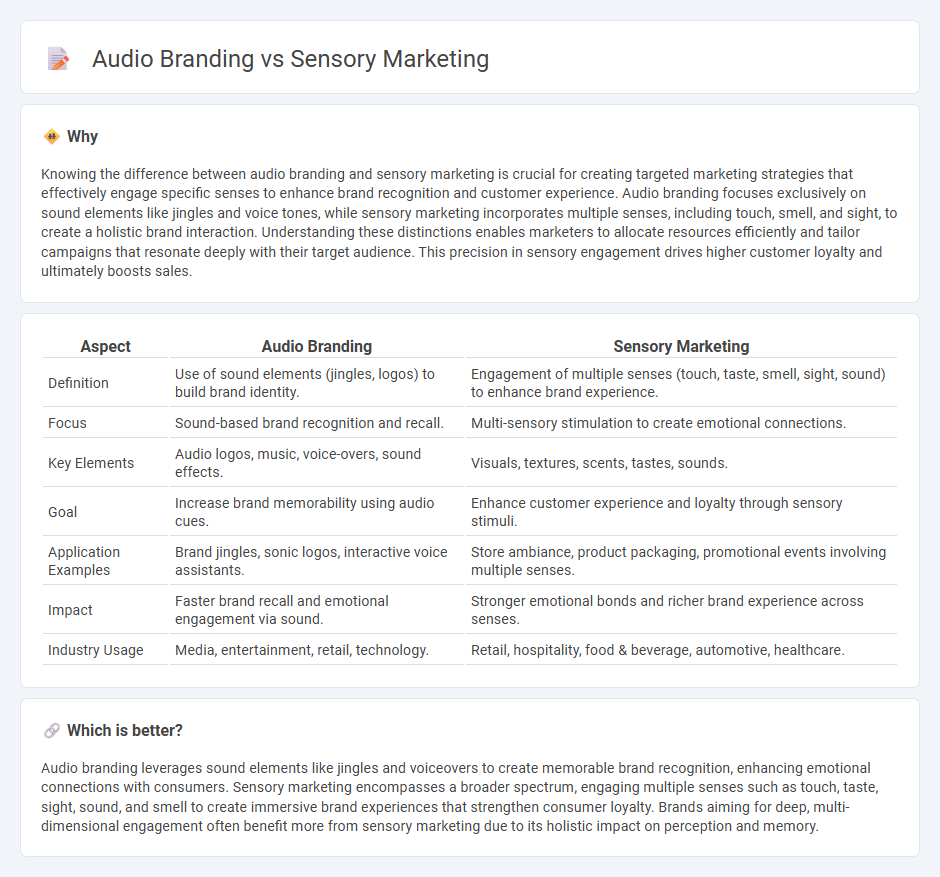
Audio branding focuses on creating distinctive sound logos and jingles that enhance brand recognition and emotional connection. Sensory marketing expands beyond audio by engaging multiple senses such as touch, smell, and sight to create immersive brand experiences. Discover how combining these strategies can amplify customer engagement and loyalty.
Why it is important
Knowing the difference between audio branding and sensory marketing is crucial for creating targeted marketing strategies that effectively engage specific senses to enhance brand recognition and customer experience. Audio branding focuses exclusively on sound elements like jingles and voice tones, while sensory marketing incorporates multiple senses, including touch, smell, and sight, to create a holistic brand interaction. Understanding these distinctions enables marketers to allocate resources efficiently and tailor campaigns that resonate deeply with their target audience. This precision in sensory engagement drives higher customer loyalty and ultimately boosts sales.
Comparison Table
| Aspect | Audio Branding | Sensory Marketing |
|---|---|---|
| Definition | Use of sound elements (jingles, logos) to build brand identity. | Engagement of multiple senses (touch, taste, smell, sight, sound) to enhance brand experience. |
| Focus | Sound-based brand recognition and recall. | Multi-sensory stimulation to create emotional connections. |
| Key Elements | Audio logos, music, voice-overs, sound effects. | Visuals, textures, scents, tastes, sounds. |
| Goal | Increase brand memorability using audio cues. | Enhance customer experience and loyalty through sensory stimuli. |
| Application Examples | Brand jingles, sonic logos, interactive voice assistants. | Store ambiance, product packaging, promotional events involving multiple senses. |
| Impact | Faster brand recall and emotional engagement via sound. | Stronger emotional bonds and richer brand experience across senses. |
| Industry Usage | Media, entertainment, retail, technology. | Retail, hospitality, food & beverage, automotive, healthcare. |
Which is better?
Audio branding leverages sound elements like jingles and voiceovers to create memorable brand recognition, enhancing emotional connections with consumers. Sensory marketing encompasses a broader spectrum, engaging multiple senses such as touch, taste, sight, sound, and smell to create immersive brand experiences that strengthen consumer loyalty. Brands aiming for deep, multi-dimensional engagement often benefit more from sensory marketing due to its holistic impact on perception and memory.
Connection
Audio branding and sensory marketing are interconnected through their ability to engage multiple senses, creating a cohesive and memorable brand experience. Audio branding leverages sound elements such as jingles, voiceovers, and sound logos to evoke emotions and reinforce brand identity, while sensory marketing integrates these audio cues with visuals, scents, and textures to stimulate consumer perception and influence purchasing behavior. Combining these strategies enhances brand recall and fosters stronger emotional connections by appealing to consumers' auditory and sensory signals.
Key Terms
**Sensory Marketing:**
Sensory marketing leverages multiple senses--sight, sound, smell, touch, and taste--to create immersive brand experiences that increase customer engagement and boost sales. By targeting a range of sensory inputs, companies can build stronger emotional connections and enhance brand recall more effectively than single-sense strategies like audio branding. Explore how integrating sensory marketing can transform customer interaction and drive brand loyalty.
Multisensory Experience
Sensory marketing involves engaging multiple senses to create an immersive brand experience, while audio branding specifically focuses on crafting distinctive sound elements that reinforce brand identity. Multisensory experience in sensory marketing leverages sight, sound, smell, touch, and taste to influence consumer perception and behavior. Explore how integrating sensory marketing and audio branding can elevate your brand's impact and customer connection.
Emotional Engagement
Sensory marketing leverages multiple senses, including sight, sound, smell, taste, and touch, to create immersive brand experiences that evoke strong emotional responses. Audio branding specifically targets auditory elements such as jingles, sound logos, and music to establish a recognizable emotional connection with consumers. Explore how these strategies enhance emotional engagement by shaping brand perception and consumer loyalty.
Source and External Links
Sensory branding - Sensory marketing appeals to all five senses to create emotional connections with customers, going beyond rational marketing to target feelings and impulses through multisensory experiences in retail and advertising.
Unlock Sensory Marketing: What it is and Why it Works - Glion - Sensory marketing uses sight, sound, touch, smell, and taste to elevate brand experience and build deeper emotional connections, exemplified by Apple's product design and Starbucks' in-store atmosphere.
Sensory Marketing | How Brands Use the 5 Senses - Sensory marketing creates reflex associations by engaging multiple senses simultaneously, triggering memories and emotions that make brands more memorable and foster customer loyalty, with 63% of consumers wanting multisensory brand engagement.
 dowidth.com
dowidth.com